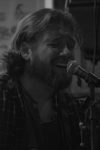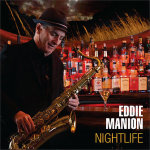 Keegan McInroe seems pretty relaxed about the whole process of touring, in fact he seems pretty relaxed all round. If you listen to his latest album, “Uncouth Pilgrims”, you’ll know that he’s travelled extensively and used his experiences to create some great songs. It’s obvious from the moment you open the door of The Lighthouse on Battersea Park Road that it’s not the ideal gig for a singer/songwriter. It’s Friday night, noisy and full of the ‘few beers after work’ crowd, but Keegan doesn’t seem too bothered; it’s a gig he’s done since his first tour here in 2004 even though the pub has changed hands and function since then. Having a quick chat before the gig, he’s remarkably unfazed by the audience, explaining that he’ll just play a few more covers than usual and some of the songs from the new album.
Keegan McInroe seems pretty relaxed about the whole process of touring, in fact he seems pretty relaxed all round. If you listen to his latest album, “Uncouth Pilgrims”, you’ll know that he’s travelled extensively and used his experiences to create some great songs. It’s obvious from the moment you open the door of The Lighthouse on Battersea Park Road that it’s not the ideal gig for a singer/songwriter. It’s Friday night, noisy and full of the ‘few beers after work’ crowd, but Keegan doesn’t seem too bothered; it’s a gig he’s done since his first tour here in 2004 even though the pub has changed hands and function since then. Having a quick chat before the gig, he’s remarkably unfazed by the audience, explaining that he’ll just play a few more covers than usual and some of the songs from the new album.
And that’s just what he did. His own material, mainly from the new album, was slotted fairly evenly into the two sets and included “Lumberjack Blues”, “Give Me the Rain”, “I Got Trouble”, “Flower Song for Barefoot Dancers”, “Nikolina” and “Lay Down”. The stripped-down versions worked beautifully live and the audience didn’t distract too much; there was even a fair smattering of applause around the room.
As for the covers, well, he didn’t put a foot wrong; he even played a couple of unexpected old favourites of mine. There were songs by the songwriting giants (Tom Waits, Townes Van Zandt, Willie Nelson, Neil Young and a tribute to Merle Haggard) and a few less predictable choices. Only three songs in, he made the brave choice of tackling Hoagy Carmichael’s “Georgia” and, despite a fairly noisy crowd, he made it work. The more esoteric song choices added the spice that made the evening unique; Stevie Ray Vaughan’s “Life by the Drop” and Warren Zevon’s “Carmelita” (both stories of addiction) introduced an element of pathos, while Muddy Waters’ “Champagne and Reefer” and Elmore James’ “Dust My Broom” (which closed the second set) gave Keegan the chance to demonstrate his blues licks.
If this gig had been in an established ‘listening room’, the audience chatter would have been hugely distracting, but it was a free gig in a local pub and Keegan took a pragmatic view of the situation, playing to the people who were interested and tuning out those who weren’t. His own songs are well crafted and worked perfectly in the stripped-down format. He’s also a really nice guy.
“Uncouth Pilgrims” is released on Friday May 27th
 OK, so just to save a bit of time, we all know about Eddie Manion, yeah? Whaddya mean, no? Where have you been for the last forty years? You really should get out more. If you want the whole nine yards, check out his Wikipedia entry, but, just for the moment, his first major gig was with Southside Johnny and the Asbury Jukes, and since then he’s played with Dion, Dave Edmunds, Diana Ross, The Allman Brothers, Willy De Ville, Keith Richards and Bob Dylan and many, many more. He was part of the E Street Band for Bruce Springsteen’s “Wrecking Ball” tour and, more recently, he’s been touring Europe with the Light of Day Foundation raising money for Parkinson’s Disease research. His motto is ‘Have Sax, Will Travel’.
OK, so just to save a bit of time, we all know about Eddie Manion, yeah? Whaddya mean, no? Where have you been for the last forty years? You really should get out more. If you want the whole nine yards, check out his Wikipedia entry, but, just for the moment, his first major gig was with Southside Johnny and the Asbury Jukes, and since then he’s played with Dion, Dave Edmunds, Diana Ross, The Allman Brothers, Willy De Ville, Keith Richards and Bob Dylan and many, many more. He was part of the E Street Band for Bruce Springsteen’s “Wrecking Ball” tour and, more recently, he’s been touring Europe with the Light of Day Foundation raising money for Parkinson’s Disease research. His motto is ‘Have Sax, Will Travel’.
Eddie Manion plays tenor and baritone sax (mainly baritone when working as part of a horn section) as well as having a pretty good voice, which you can hear on his first solo album, “Follow Through”, released in 2004. At the end of the gargantuan “Wrecking Ball” tour, Eddie started work on his second solo album “Nightlife”, opting this time for instrumental interpretations of standards and not-quite-so-standards, rather than his own compositions. It’s a double-edged sword. Both ways you’re going to be judged; one way you’re compared with others’ songwriting, the other way you’re compared with previous versions of the same songs. So how does “Nightlife” shape up?
I guess it’s natural for anyone who’s spent their entire adult life as a professional musician to want to do their own thing once in a while. Eddie Manion’s spent a lot of time playing in horn sections in big bands where nuance isn’t always too high on the agenda, so when the window of opportunity opened, he pulled together a superb bunch of musicians to make an album placing his sax playing firmly stage centre against a backdrop that allows him to interpret songs with style and subtlety. From the album’s opener, a gorgeous version of the theme from the 1961 movie “Town Without Pity”, with its piano triplets and wah-wah trumpet, to the closer “”The Only One, from Roy Orbison’s final album, the album demonstrates Eddie’s ability to create flawless interpretations of jazz standards such as “Smoke Gets in Your Eyes” and “Stardust” whilst also combining Springsteen’s “City of Night” in a medley with King Curtis’s “Soul Serenade”.
Throughout “Nightlife”, Eddie Manion combines a jazz-styled finesse with a rawer rock edge to create a satisfying and varied set of instrumentals that embody great musicianship and sympathetic arrangements. If you value musical skill and the ability to pick a good tune, then you’ll love this; Eddie’s a superb player and he’s surrounded himself with like minds to produce a real musician’s album. As an added bonus, Eddie’s also a very good photographer and the CD packaging includes some of his own fabulous photos taken mainly on the “Wrecking Ball” tour; it’s the icing on the cake of a lovely album.
You can order it here.


